November 8, 2004
Monkeys

WW#179
First, a caveat:
The appearance of transparancy in this blog (if it indeed seems so to you) is illusory. First of all, not everything can be blogged. Too many times, I have seen or entertained remarkable thoughts/experiences, knowing it could be great blog material ... only to have it float away in a lifestream for various reasons: an embarassment of riches, the need to be discrete, the simple need to not bias the depiction of what goes on here by transcribing every neurotic thought that floats through my cranium (what, you don't have them?). For heaven's sake, a blog is not a stage that the actor should grandstand constantly with over the top emotion. And this blog will not bore you with mundane yet important notations of the sometimes harrowing financial brinkmanship that is the lot of every artist's life (I wonder what the curve of the relative incomes of artists would look like?)... or perhaps such a reportage might be exciting and instructive in a live-by-your-wits kind of thing, but it would be not so good for the people you work with. This is not a dear diary where I scribe my vulnerable innards... I think of it more like a bibliography that occassionally resembles a biography. And for heaven's sake, this won't be a variant of the mental disorder where one would compulsively record daily temperatures or count food intake and bowel movements (there was one blog that did exactly that, a Jpeg a day of the toilet... it was like a car wreck, revolting and yet you couldn't take your eyes off it), nah, not that.
The most important thing here is that I feel a need for some mental processing, to do it in writing. It is relevent to what is happening in the studio, where, if this bibliographyblog functions correctly, is central to its mission. It's my side of the story.

WW#180
As you read what's to follow, please remember that my mood is light, even though I may heave a sigh or two or wring my hands. Sweaty hands. Writing online has difficulty conveying emotion and inflection correctly. People can misunderstand the tone. That's why they invented emoticons:
;-)
WINKY EMOTICON ON!

WW#185 "Lush Life"
So here's the news: I got a crit on the show in Z?rich, and it was... let us say... complex. I heard from a friend of a friend that they thought the show in Z?rich was...
"Not as strong as the work before".
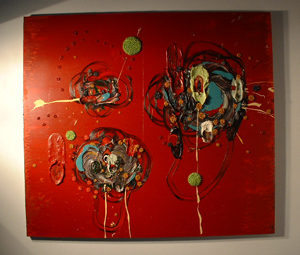
WW#191 "Cadmium Red Deep"
Please, don't misunderstand me. I'm not a fragile flower. I've lived a life in presentation contending with fierce feedback on the work I've done. I've given it with gusto and I've gotten the same. As a matter of fact, the first show of my wet in to wet work recieved a blistering whipping in a smaller weekly newspaper (I don't seem to have the link at my fingertips, alas!), the good news is that the critic went waaaay over the top and -at least for me- lost credibility. Still, The first of my crit conditioning was architectural, a big audience situations which are systematic versus art crits, which tend to be small scale and psychological.
Even so, my heart sank a little. It always does. It must be a masochism.
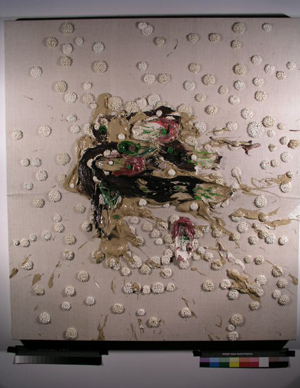
WW#194 "Carnal"
But critique is key and important and essential, art as we know it wouldn't exist without it. But why am I drawn first to the harsh crit? When I was teaching (architecture design, '92 to'00), the school had an evaluation system that resulted in the instructor recieving a bundle of reviews in longhand. Longhand. And no matter how many glowing essays that might come my way, I went straight for the harshness. I guess I like to take my licking first and then the balm later.
Anyway, to repeat the critique: the idea was that compared to the work I did before, the paintings painted in Tossa were too much the same and not as strong as before.
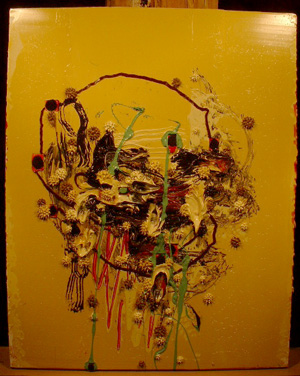
WW#203 "Actor"
They might not be seen as strong, but they have an internal imperative that leaped over the previous work. They are indeed different, they are of a language that appeared in the first painting. From my view, it was a departure from what had gone before. It was both continuous with the previous work but it was different in an unexpected way. There seemed to be a language and syntax in the first painting, a strong armature that could be tested elastically.
(NOTE: I speed picked these images to plumb a sort of recent visual history. The work in question begins at WW#210.)
All of this is normal steaming. The reason why the issue enlarged is that the other day, I gave my mom a call to say hello. I mention that crit to her and it was if a dam burst inside her. She quickly concurred. She said the work seemed washed out compared to my previous work, she said:
"It seems as if you were... empty inside."
Dear G-d.
"Maybe you are cooped up in your studio too much. Maybe you should get out more."
It was as if I were in the second cockpit and the pilot decides to barrel roll. There might be a popular perception that the work is indeed weaker than those before it. These critics are people who have seen the work before. Am I being compared to my older self?
Wow.
Strange that in the world there are forces that want you as an artist to change, to question your project, to shake it up, to upset the status quo, to surprise... and there are equally agressive appeals to cohere, to refrain from caprice, a challenge to hold the note, to commit to a visual language, a sensible life project. One time, Rauchenburg said to me: "Change it up, do something different every show." Then, I overheard advice from Lasker to a friend: "Find your project and stay there."
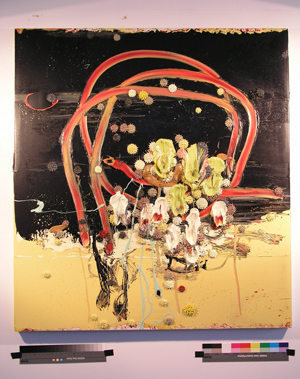
WW#208 "Thoughts Afield"
She said that they looked grey. And to a great extent, they are greyer, less saturated with color. They are coming off WW#210, "La Primera Vez", the first painting I for the show and since arriving in the EU. I was grooving on the pastoral history of this new place. It was for all purposes, a landscape painting.
Sky's a blue, the white walls of the pueblo, terra cotta of the earth, sprites of green of vegetation, shots of ochres and blues and that strange electric green here and there. I was delighted by the feat of the move, enchanted by the Costa Brava and the Catalans. Nature was closer to us than it was in LA. Here, you are in the froth of the landscape, embroiled.
This is important: there are two levels here.
No matter what the case is with what is beginning to resemble a triagulation of opinion, my arrival in the EU should be a bigger splash than this. It cannot be denied that there was a coming short of the goal of having the work seen hands down as fabulous stuff. As a friend once said: "It's show-business, Dennis! "It's a business and you've got to make a big show about it to get any. I never got warm to that idea. But it is one that is dangerous to turn your back to.
I like the idea, which I first remember Dave Hickey articulating, that the artist first had to have their own party before others will want to join in. The artist is the first audience and then the rest of the world might follow. Emphasis on "might". That's what is a little wobbly here.
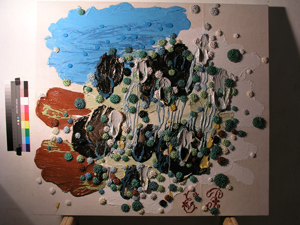
WW#210 "La Primera Vez"
People aren't seeing what I'm seeing. Since I can show you with this weblog, I think I'll point a few features I see in this recent turn in the work. (All images illustrating this post are arranged chronologically, there is no scale in terms of time or in size of the work.)
First of all, I busted out of the procedure of screeding a level bed of paint across the entire surface of the painting in sheets. I usually pulled it down from the top to the bottom. This came from my regard for the first time I painted like this, a wet brush laying into a field of wet paint. Painting this way was like creating a "paper" in which to begin various kinds of "drawings" that agglomerate loosely into the eventual painting. I did this by first laying paint down with these pillow-like tools I have. You see, this way, the painting doesn't have to start top to bottom in a sheet of color. I can begin in any part of the canvas... and only in part of the canvas, rather than commit to the entirety of the surface.
Now, I didn't have to paint the whole thing at once. At least that is the theory.
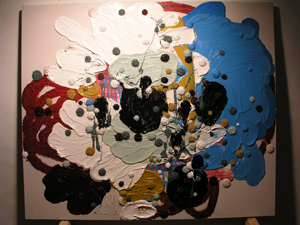
WW#214 "Out of the Head"
You see, I have a divided head about the size and scale of the canvases. I've long felt that these paintings had a scale about them. The details of form, the lick of impasto came from the hand, a hand that earned their chops. For that reason, the works on paper are perfect: I think that the size of a sheet of stiff paper is scaled perfectly to the hand and delicacy of the paintings I'm doing. Larger canvases bring a harder intensity to the project. A stiffer support can absorb more joules of energy and therefore it should. Do you remember whe I said that sometimes I get that Tuttle Feeling?
Richard Tuttle is great for keeping it simple, keeping the work in his hands in front of him. Or what about Giorgio Morandi? That guy did the same thing. Human scale.
I've always wanted to change a museum as they exhibit the work, rather than change the work to fit the museum. If I had to show in a soaring former factory building now a kunsthalle, I'd drop the ceiling and put spots on the paintings at high raking angles.
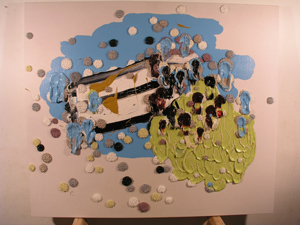
WW#217 "Muchas Cosas"
The trouble with me is that once I dwell on one thing, I begin to form contrary thoughts. Once I begin to nurse what feels like a manifesto-like idea, I plant seeds for the other point of view.
Before, I began to become critical of the inhumanly scaled, institutional scaled global international language former factory space cum kunsthalle... part of my head began to agitate the problem of painting larger. The paintings done this summer bear seeds of a way to paint larger works.
Funny how that happens.
So, one way to extend into a larger surface was to work like a mural painter, one patch at a time. Another way to address the larger surface came from the late development of color areas scraped flat as I begin the painting. This seems to bear a promise of drawing large areas of the canvas (in which my mental image is Monique Prieto's work, so I'll have to be careful there... or better, Al Capp's Shmoo's in his lil' Abner cartoons). I can begin with a drawing of fat lines that almost become fields.
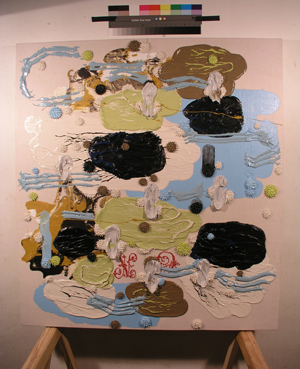
WW#218 "Grace"
There is the persistant issue of needing to arrest the attention of the audience (I like Joyce's idea of arrest in his "Portrait..."). I have to be wary of any hint of pandering to an audience of course... but there's this monkee on my back: Am I painting because I want to be accepted, or am I following the lead in the works themselves?
Here's the solution: a venn diagram of my needs and the audience's needs, there is an overlap. Two conclusions:
1. Paint larger.
2. Find and embolden the punch in the work to come.
Posted by Dennis at November 8, 2004 1:55 AM
Thanks for your post. I was feeling low about my performance on a panel today about content in my work, but after reading what you've said I was reminded that even what I perceive as a shortfall is a necessary component in the bridge-building into my next batch.
Anyway, I like the way you're feeling your way into your work to come. Those new ones aren't weak.
Sherie'
Thanks Sherie!
I remember an acquaintance once saying that once an artist produces that seminal work, the groudbreaking work, the stuff seen and known as great work... that all other work done in the past will be seen as possessing seeds of that greatness. A kind of back validation it is.
I like this because the promise (redemption?) is open to all who strive.
Keep striving.
(!)
-Dennis
Fun....................